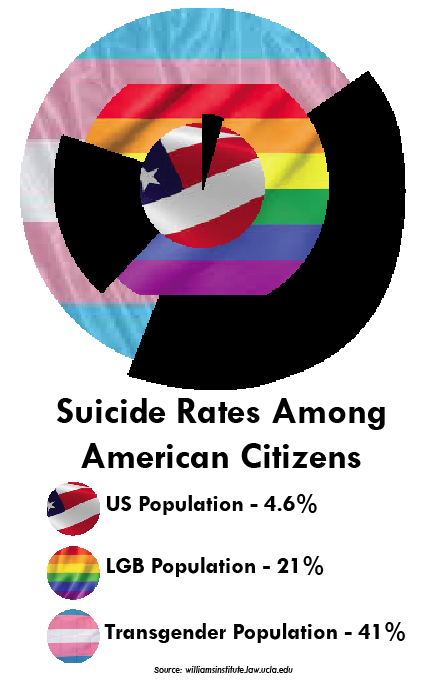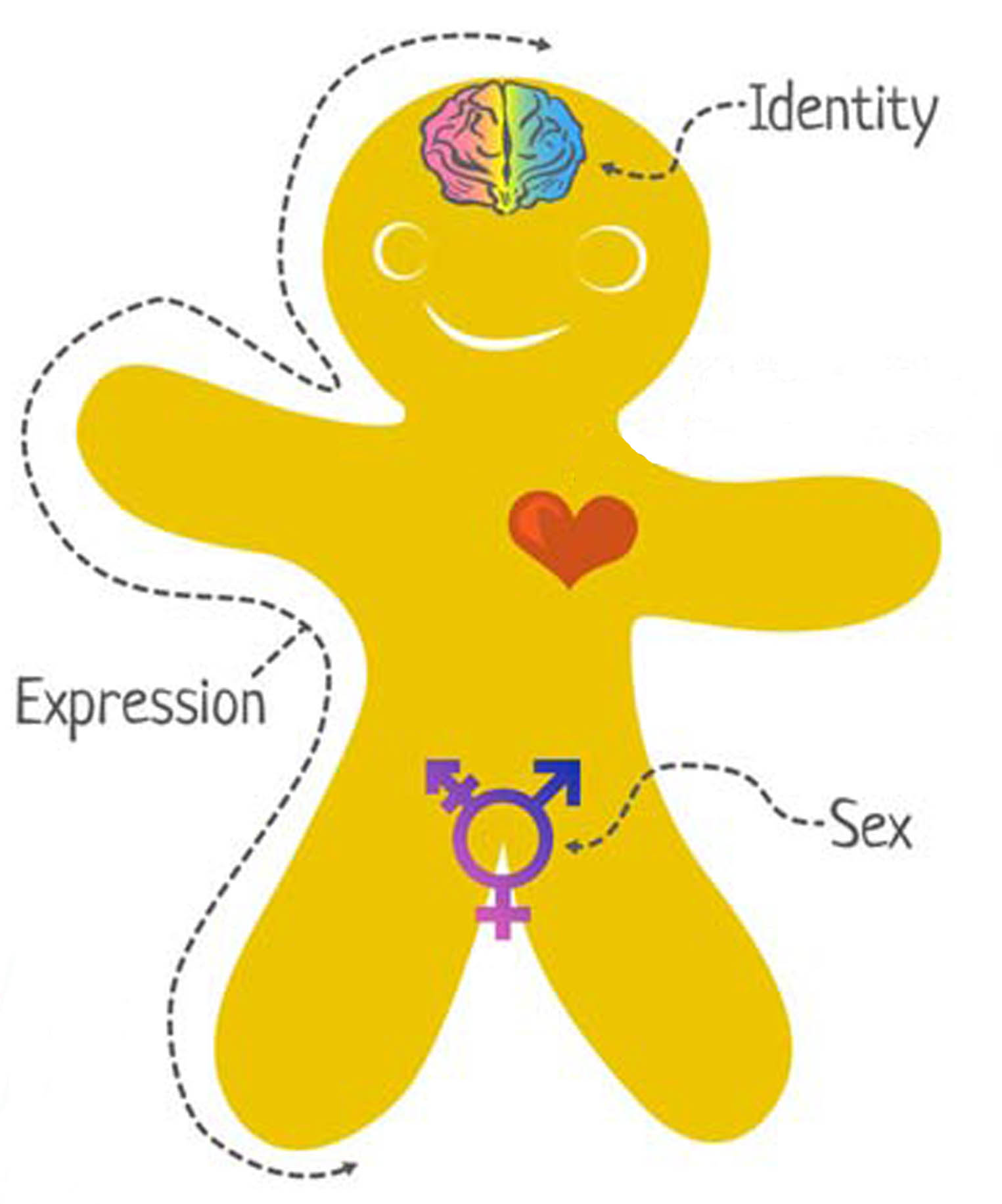Transgender students are at risk: Studies show creating safe, supportive school environments can have a big impact
By Megan Sarns and Julia Bell

From the highly publicized transition of Caitlyn Jenner to the Target boycotts, the transgender community is being widely discussed. However, with this new platform comes controversy as to how schools should approach such a sensitive topic. Much of the controversy is rooted in confusion and misinformation.
When talking about the Lesbian, Gay, Bisexual, and Transgender (LGBTQ+) community as a whole, the idea of “equality” is widely spoken of. The word has good intentions but a complicated meaning. It’s a common misconception that equity and equality can be used interchangeably in terms of ensuring fairness. Equality refers to providing every individual with the same resources and opportunities. It’s an imperfect system because individual strengths and needs are not always accounted for.
“Providing equality to students can provide more privilege to some students and still not provide enough opportunity to others, when given the same assistance,” said Autumn Campbell, art teacher and Gay-Straight Alliance (GSA) facilitator at Dexter High School.
Equity, on the other hand, does identify the strengths and needs of students and helps everyone in different ways. The goal is for every student to be at the same baseline for success.
Just like any group of students with specific needs, transgender and gender nonconforming students that attend DHS now, or will in the future, require a specific type of assistance to thrive.
According to psychological studies, individuals identifying within the LGBTQ+ community are up to three times more likely to have a mental health condition, such as depression, anxiety, and posttraumatic stress disorder. These conditions can sometimes lead to self harm, substance abuse, and even suicide.
“A lot of people don’t understand; they think these students are doing this because they want to or for attention,” DHS counselor and GSA facilitator, Kristie Doyle, said. “But when you look at the statistics, the evidence is there…these students are at a much higher risk for mental health conditions.”
This problem gained national attention when Caitlyn Jenner accepted the Arthur Ashe Courage Award at the ESPYs in July of 2015. In her acceptance speech, she implored her audience to take notice of the staggering number of transgender youth that are bullied and abused by their peers and families to the point of considering suicide. According to a 2015 survey, 4.6 percent of Americans report having attempted suicide at some point in their lives. Within the lesbian, gay, and bisexual community, that number climbs to 20 percent; within the transgender community, it is 40 percent.

In 2014, the death of Leelah Alcorn, a transgender high school student from Ohio, sparked a national conversation. When Leelah, born Jacob, attempted to come out to her parents as a transgender female, her parents refused to allow her to undergo transition treatment and sent her to conversion therapy instead. When she began coming out to her friends, her parents removed her from her high school and restricted her access to social media. She lost contact with the friends she was once able to confide in. Leelah committed suicide on December 28, by walking into oncoming traffic on the Interstate 71 highway. She was 17 years old.
Leelah posted her suicide note publicly on social media, posthumously turning her into a martyr for transgender youth across the world. Nevertheless, situations like these are all too common.
The reason transgender people are at a higher risk has been studied by countless psychologists over many years. Several factors have been cited, but one reason stands out above all the others: a lack of support within their families, peer groups, and communities. Even if a transgender student doesn’t have the support of their family or all of their peers, creating a supportive environment within school, a place where teenagers spend most of their time, has been known to have a big impact. Studies have shown that having a strong support system, wherever it is they can find it, can decrease a transgender person’s chance of committing suicide by more than 80 percent.
If a school is unable to provide accommodations to meet the specific needs of their transgender and gender nonconforming students, it doesn’t go without consequence.
Data posted by Trans Student Equality Resources in 2013 stated that 80 percent of transgender students report feeling unsafe at school, resulting in poor grades and difficulty advancing in their academic career, leading them to miss school regularly or drop out altogether.
“As an administrator, I want students to feel like they want to come [to Dexter High School] every morning,” Principal Kit Moran said. “There can be anxiety about a big presentation or a test…but when a student is anxious about coming to school and being harassed, that’s a problem.”
Working with the GSA, Autumn understands the importance of prioritizing the safety of these students.
“Our goal is to provide safe spaces for all students,” she said. “They shouldn’t have to wait for it to get better…it should be better now. All students should be able to thrive, not just survive, in our schools.”
There can also be consequences for the school if these students’ needs continually go unmet. Discrimination against any group of students based on race, class, sexual orientation or gender identity and expression by their school is a legal issue. Title IX, a portion of the United States Education Amendments of 1972, states, “No person in the United States shall, on the basis of sex, be excluded from participation in, be denied the benefits of, or be subjected to discrimination under any education program or activity receiving federal financial assistance.”
In 2014, a memo distributed by the U.S. Department of Education extended these guidelines to include transgender students. The memo reads that “All students, including transgender students, or students who do not conform to sex stereotypes, are protected from sex-based discrimination under Title IX.”
If a school ignores these guidelines, they are at risk for a lawsuit that would not only cost the school district lots of money, but their reputation as well.
In 2014, four Detroit-area schools were being sued for allegedly discriminating against a transgender student. The schools’ administrations allegedly subjected the student to continuous verbal abuse and banned them from using the restroom that coincided with the gender they identified with. This was only one of many nationwide cases.
In December of that same year, a court in Maine awarded the family of a female transgender student $75,000 in settlement after they won a lawsuit against her school administration for requiring her to use a staff restroom instead of the student girls’ restroom.
In regards to how DHS is handling themselves in situations like these, Moran’s answer is simple.
“We cannot discriminate against transgender students [at DHS],” he said. “The law said students can go in the bathroom of whatever gender they identify with…schools who don’t follow the law will not be supporting their students.”
Moran stated that DHS, alongside all other public schools in the country, received a letter from the Obama Administration last spring compelling them to regulate students’ access to bathrooms and locker rooms based on their gender identity, rather than their biological sex.
Over the past year, this policy has become controversial (a federal court in Texas blocked the edict in August), but thousands of schools nationwide have chosen to follow its guidelines. Many have expressed concerns that a more fluid regulation of spaces, that were once specific to following the gender binary, could promote an increase in sexual assaults. The facts say otherwise.
Sources such as the Transgender Law Center and the American Civil Liberties Union state there is absolutely no verifiable data to confirm reports of transgender people assaulting non-transgender people in public restrooms, and that claims of this nature are often fabricated to perpetuate violent stereotypes against the transgender community.
In fact, if anyone is at risk, all data points to the transgender people themselves. Studies suggest that approximately 70 percent of transgender and gender nonconforming individuals have been assaulted or otherwise harassed while using public restrooms. However, “bathroom bills” only work towards resolving a small part of the problem.
A study done by the National Center for Transgender Equality and the National Gay and Lesbian Task Force in 2009 found that the systemic discrimination and abuse faced by trans people extends far outside the bathroom.
According to their surveys, transgender people face up to double the rate of unemployment (keep in mind that this survey was taken during the economic recession, when unemployment rates were already high), and 97 percent of those surveyed reported that they had been mistreated at work. They have also faced a high rate of poverty and homelessness, with 19 percent of the sample having been homeless at some point in their lives.
Solving this problem begins with acceptance.
“We want [students at DHS] to take what they learn into adulthood,” Moran said. “We’re known for having high test scores…our kids go to good colleges, but we also want to be known for being accepting of every student. It’s not just about educating [your brain] on math and science…we’re educating the whole part of you.”

